Autotech interview with industry leader C. William (Bob) Heeblehauser
By Phil Austin
Autotech magazine, August 1988
photography by Mark Chen
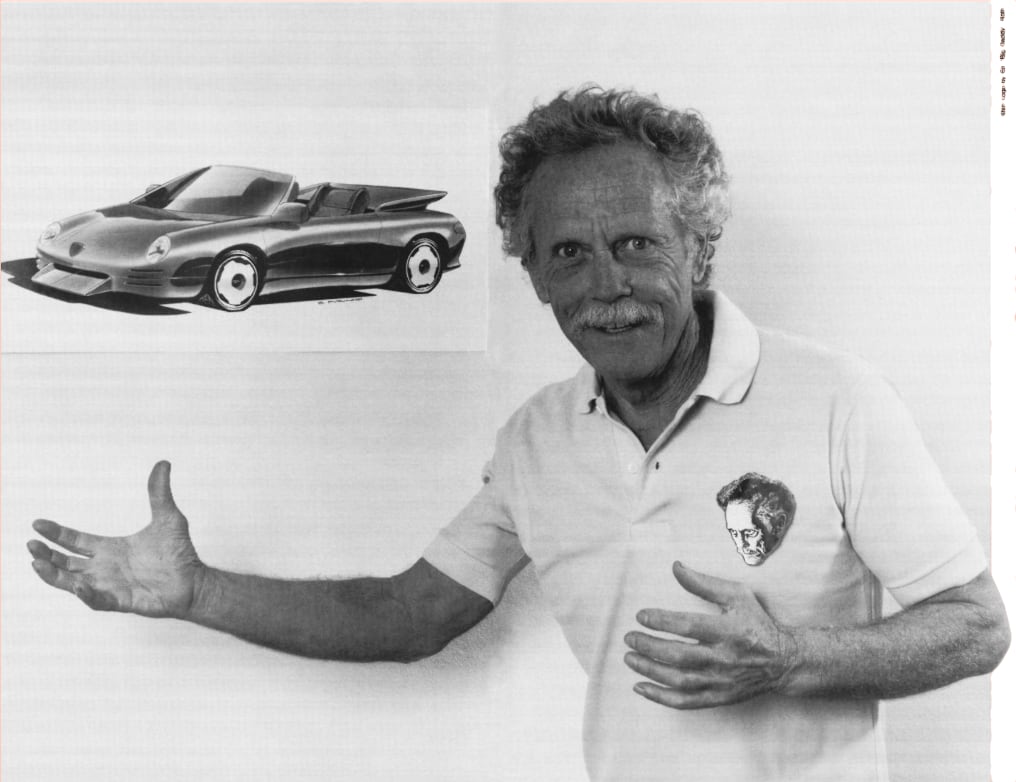
If he seems much more youthful than the 62 years for which his official biography gives him credit, it seems par for the course with this remarkable man. He is, after all, one of the youngest CEOs of an automobile company in the history of this or any other country.

The company is young too. Young and huge. Western Motors is his creation in a way that Ford or General Motors never could have been, although he has put in his time in the upper echelons of each of those giants. His name is not new to anyone who has followed his exploits in the newspapers throughout his celebrated career.
We all know the story now; how he rose into the public eye as a daredevil racing driver. The firm hands and rock-hard blue eyes still show the reflexes and daring of a man groomed on the dry lakes of California and the salt tracks of Utah, in a gutwrenching sport called Crazy Eights,
pioneered in the ’50s by the outcasts of the racing fraternity and known officially (and quite respectably) now as Banked Double Oval Stock Car Avoidance Racing.
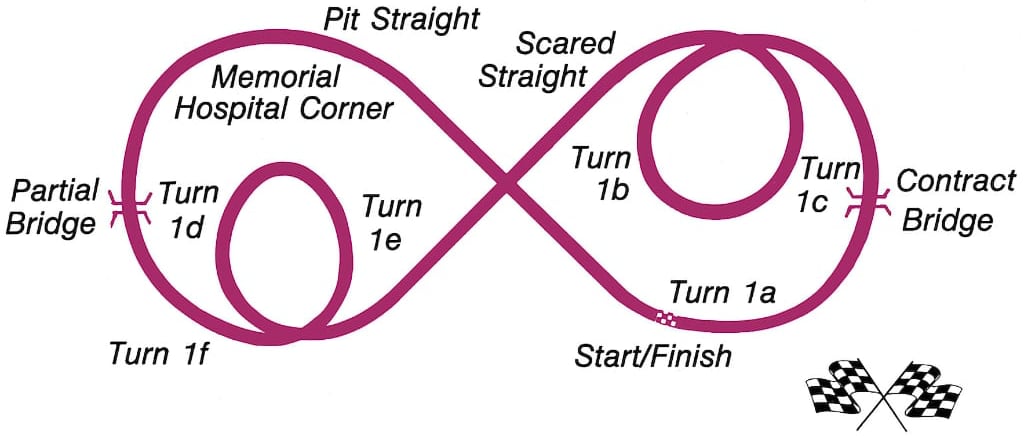
C. William Heeblehauser is his name, although friends and family have called him Bob
since he, as a small child, began insisting that it was his name. It is just this kind of persistence and vision, combined with a stubborn individual sense of destiny, that have taken Bob Heeblehauser from the hallowed halls of Stanford down to the depths of Crazy Eight racing and back up into the sunshine of single-handedly running a multi-billion dollar corporation whose first car will hit the showrooms of its own dealerships within the next year.
We talked with Heeblehauser one evening in his executive office — called The Showroom
by his employees — which sits atop the massive administrative complex of Western Motors’ headquarters just outside the city of Las Vegas in southern Nevada. Dressed casually in bright red slacks, a yellow golfing shirt with a likeness of his face embroidered over the left breast, and bright-red golf shoes with two-inch cleats, Bob Heeblehauser looked out over the neon-lit city of crapshooters, leaned back in his swivel chair, and talked about his career and his life.
Autotech: Your chief interest seems to be the production of what has been a dream of yours since you were very young; the Beavertail SCX170 sports car. Many are claiming that this obsession is so expensive it will sink Western Motors financially. In fact, several members of your own board of directors recently told The Wall Street Journal in an interview that they feel collapse is imminent unless the company goes back to its original plans to import Korean lunch boxes, refit them with Laotian two-cylinder engines, and ship them to Europe for sale as urban all-terrain vehicles.
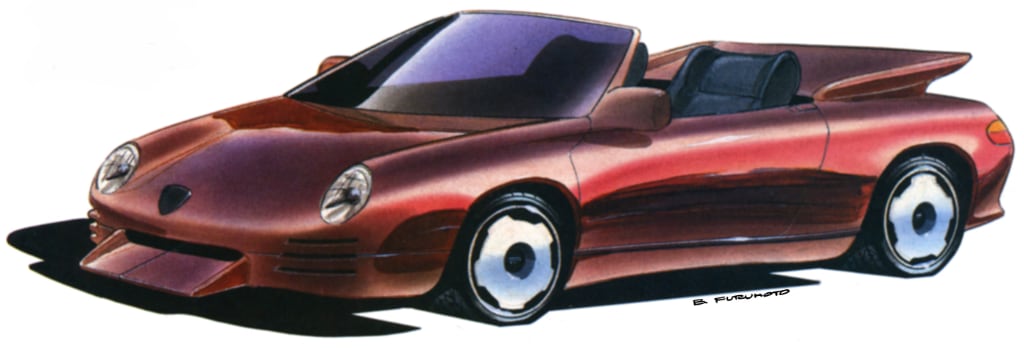
C. William (Bob) Heeblehauser: Listen, I don’t have any quarrel with the board at Western. I understand their anxiety. But I come from a school that says that if you don’t go forward you are probably going to be hit from behind by something you would have missed if you had been going backward.
AT: By school
do you mean Speleotis Junior High School in Pittsburgh?
CH: (laughing) No, no. I meant the School of Hard Advanced Knocks at Harvard. I did two semesters of post-grad work there in the late ‘70s and I sure learned my lesson.
AT: Are you saying that your dream of an unaffordable sports coupe that so far has only garnered laughter from competitors and friends alike is worth more to Western Motors than just showing a profit?
CH: Let me put it this way. If you mean that I’m in love with the Beavertail SCX170 and have been ever since I was in junior high school, then you’re right. I’m a sentimental guy and if you cross me I will hurt you in a sentimental way. A word of warning for the boys on the board of directors; if you hire me, you hire my dreams. So just let me dream until I’m through.
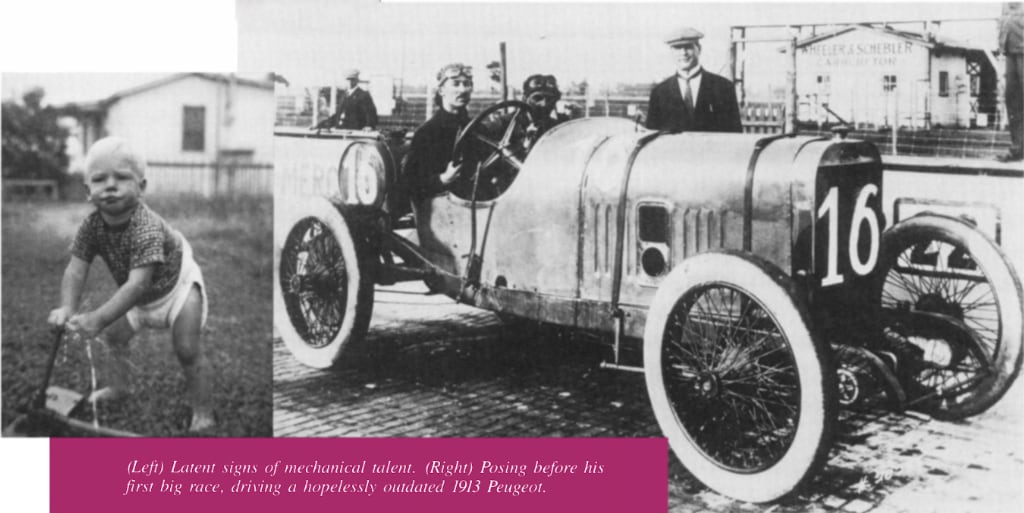
AT: And when will that be?
CH: When will what be? What were we talking about?
AT: Did you do the original design for the Beavertail SCX170 yourself?
CH: In fact, I did. It is an interesting story. Or at least I find it interesting. I was in detention class — in those days there was a lot of interest in teaching kids how to be detained — at Speleotis one day when a great idea came to me. Now I’m not a particularly religious man but when something of this consequence occurs to me, it makes me stop and think. It makes me consider my own destiny, if you see what I mean. I was the kind of dopey kid who liked to design cars of the future and such. I had always been fascinated with the pure shapes of cars. And I was drawing in class …
AT: Drawing a car?
CH: Actually, I was drawing a humorous sketch of Mr. Beavers, the teacher.
AT: I am beginning to lose track of the point here.
CH: Well, the point was to draw Mr. Beavers with real big teeth — like a beaver. Get it?
AT: Of course I get it.
CH: Well, some do and some don’t. Anyway, I began to combine that sketch with an idea I had for a car. I began to improvise, to just let my mind run free, if you know what I mean.
AT: I know what you mean.
CH: Well, adding a nice, fat beaver body to Mr. Beavers seemed like a good idea and then I thought, ‘Why not make the head the whole car?’ And that was it, that was the big idea that was to influence the rest of my life. It’s funny how little things can become big things.
AT: Funny in what way?
CH: Well, some see it and some don’t. The beaver shape makes excellent sense both aerodynamically and design-wise. You see, the tail of the beaver swims through the water just the way the Beavertail SCX170 swims through air and asphalt, or at least that is what my engineers tell me.
AT: Is that how the car got its name?
CH: I really don’t have any idea. I would have to do some checking and get back to you on that.
AT: How is the car manufactured?
CH: It is made all over the world, each and every part. For instance, the steering wheel is first fabricated in Hong Kong, then shipped to Taiwan for coating, then to Kentucky for plating. It is then knocked down for shipment to Bangkok where it is reassembled to satisfy local content regulations and eventually labeled, then sent to Cooperstown for induction into the Hall of Fame.

AT: Aren’t you thinking of baseball?
CH: No. Oddly enough, the Steering Wheel Hall of Fame is in Cooperstown quite near the Baseball Hall of Fame.
AT: Let’s talk for a minute about a subject that seems to arise often these days. That is, the persistent rumor that you may be thinking of running for public office, in particular, the office of President of the United States.
CH: (laughing) Well, that’s just not true. Or if it is, it isn’t just yet. Or if it isn’t at all then it might be but not in the conceivable future. That is, not yet … but maybe. You will find I’m unequivocal on this point. More or less.
AT: That seems pretty clear to me.
CH: That’s what people who are close to the political scene say. Frankly, a lot of professionals think that this country, after surviving several years with an actor for president and all the ensuing confusion between reality and fantasy, might indeed welcome the candidacy of a solid corporate figure like myself. And that is why we may make a run at it.
AT: You mean like in a test situation where dummies are strapped into a car and hurtled against a wall?
CH: I think that’s exactly what I mean. I envision a presidential campaign that has style and dignity. But of course, I’ll do whatever it takes to become elected.
AT: You certainly gained that reputation as a Crazy Eights racer.
CH: You mean a presidential reputation?
AT: No, a reputation for doing whatever it takes. More than a few of your former competitors sport withered limbs and steel plates in their heads from encounters with you.
CH: Heh, heh. I guess I never have been shy.
AT: You came to prominence through a series of television commercials last year promoting Western Motors. That advertising campaign might as well — in many people’s eyes — have been political. In other words, the intent of the advertising seemed to be to sell you rather than the cars. The commercials, for instance, showed you as a family man, as a farming man, and as a man of the people, as well as a man of immense wealth. But not as a man with a car. Why were cars never shown in any of those ads?
CH: I said to my people that we must first have a reputation, and you can’t build a reputation in this business by exporting urban all-terrain vehicles that have been banned from staircases in every state of the union. Admittedly, many of the world’s more backward countries do have a more enlightened attitude toward American industrial rejects, but it’s really the domestic sales that count. And because we didn’t have the Beavertail SCX170 ready to go, I figured that the best way to overcome all the resistance would be to just go on the air and build confidence in what we did have: Me. And it worked. Here we are with relatively little water over the dam and we already have a product, almost. But most importantly, thanks to television we have a confused public ready to drive whatever I drive. And you know what I’ll be driving.
AT: Will future commercials delve so deeply into your personal life? The last commercials certainly were arresting.
CH: You’re referring to the lawsuits now. There was never any truth to the rumor that I was arrested. That woman wasn’t my wife anyway. She was just an actress hired to portray my wife.
AT: But you never had a wife in the first place.
CH: Incorrect. I have several ex-wives in good standing in the communities in which they are housed. Nothing in those ads said that I was currently married to that woman. She could have represented any one of my ex-wives just as easily as she could have represented my current wife.
AT: But you don’t currently have a wife.
CH: Are you sure? I’m sure I must have one. TV ads never lie; they’re not allowed to. I read that in TV Guide.
AT: Then those pictures of you in jail were what, just gag photos?
CH: Uh, yeah. That’s right. Just a gag. You know, a boys-down-at-the-office sort of thing. A lot of our upper-echelon executives have served time in minimum-security facilities, and it has permanently affected their senses of humor — as well as improved their golf games.
AT: If you do run for President, aren’t you worried about the criticism that your manufacturing philosophy evokes from strong protectionists and others among the American public who find your global approach to manufacturing reprehensible?
CH: No, I’m not. And I’ll tell you why. One thing I learned real well in Crazy Eights racing is that you have to aim right at where the accident already is, even if the accident has happened to you. Here in the United States the accident has, in a sense, already happened. We have lost our place as a first-class manufacturing and exporting nation. So you aim right for the accident. You focus your attention on importing and non-manufacturing — if that is a word. In short, steal from the world because they have already taken everything away from us anyway. Try to own the world and don’t let the world buy us. Is that clear enough?
AT: Well, not really. I mean, many people would say that what you have said makes very little real sense.
CH: That’s all part of the beauty of it. Nothing makes much sense anymore, so get with it. That is the message. Don’t give your competitors the edge by making sense. Don’t make any sense, that’s the way to go.
AT: Really! What about those time-honored American virtues of honesty and truth and reliability?
CH: Forget them. It’s a new age. Go on to something else.
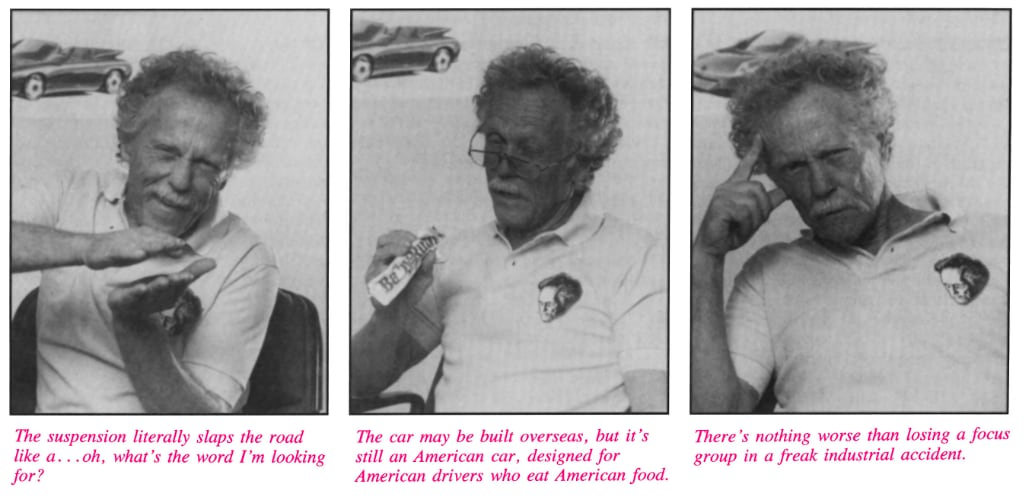
AT: Let’s talk about power. We have heard some pretty outrageous rumors about the SCX170’s engine.
CH: They are all true.
AT: They can’t be. From what we hear, the SCX170 is supposed to run on smog.
CH: That’s right.
AT: You‘re kidding.
CH: I haven’t made a joke about the Beavertail SCX170 since I was in junior high school.
AT: What was that joke?
CH: Who cares? Next question. On second thought, let me take a minute here to just explain myself. The Beavertail SCX170 is the car of the future; that’s one thing we know for sure. Our research people have checked on that and it’s true. Fuel is taken in through the extra-large intake system that is unconventional in the sense that it is placed in front of the chassis. Two big hairy intake manifolds suck the air into a compression chamber or head
as it is called. Because the fuel source is in the air itself, it stands to reason that lots of air needs to be sucked in. I can’t go into much more at this time because the processing or refining
of the fuel-rich air is a secret. I can say that the powerplant is a conventional 2.7 OL, multiport, air-injected BHT V6 that you might find anywhere. One added benefit that I can reveal is that because the car creates pollutants — puts them back into the air — it is in that sense helping on fuel economy for everyone and solving the environmental conundrum that has bothered this industry for some time.
AT: You seem to be saying that the car will create more pollutants, which will be balanced because the car will also eat the pollutants.
CH: Well, actually, the car behind our car will eat the pollutants. It would just be lucky for the driver behind if he was driving a Beavertail SCX170. That’s what I meant to say.
AT: How are the big oil companies responding to the introduction of the Beavertail SCX170?
CH: With a lot of bad humor. They just don’t seem to want to play ball with a manufacturer who has got a car that consumes, essentially, air. If some of the big boys can figure out how to pump air or package it, I guess they might be able to keep up. We see the country going for the Beavertail SCX170 in a really big way.
AT: How can that be? The rumor is that the car will cost more than $120,000, and that is for a two-seater with no trunk space.
CH: Oh, the car is a little expensive, yes. But think of the savings on fuel. For instance, you can drive clean across this great green nation of ours by getting right on someone’s tailpipe and consuming their exhaust.
AT: Why is the car called the Beavertail?
CH: Because it looks like a beaver tail. It’s low and flat and wide for less weight. It literally slaps the road like a beaver slaps the surface of the water.
AT: Isn’t that hard on the suspension?
CH: Well, there is no suspension. At least, not in the conventional sense of the word.
AT: No suspension?
CH: That was my idea, too. My engineers have designed a way to make the road surface itself serve as the suspension. In so doing, we also managed to reduce the cost of the car considerably.
AT: That’s quite interesting.
CH: More than just interesting, it’s revolutionary.
AT: Sounds like it will make chiropractors and orthopedic surgeons very happy.
CH: We want to make everyone happy, especially me.
AT: One last question. All kidding aside, how did you come up with the name?
CH: Beavertail SCX170? Let me think. I believe it came to me in a dream.
AT: What sort of a dream?
CH: A bad dream. Kind of a nightmare. With beavers in it.
Source: Phil Austin, Autotech magazine
Best known as Nick Danger
of the Firesign Theatre, film and television writer Austin is a slave to the restoration of his 1967 GMC Suburban, once described by two guys on the street as a cool ride.